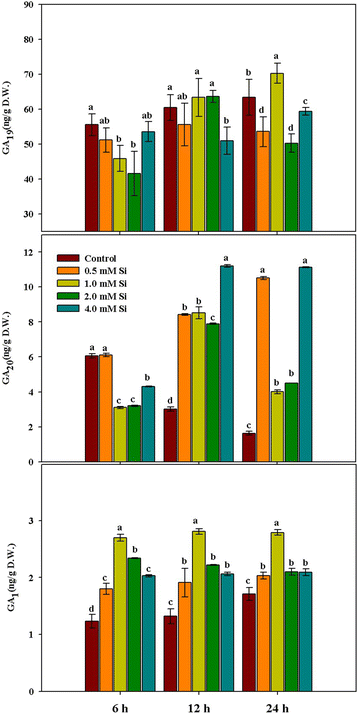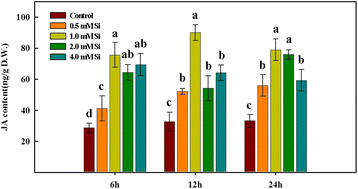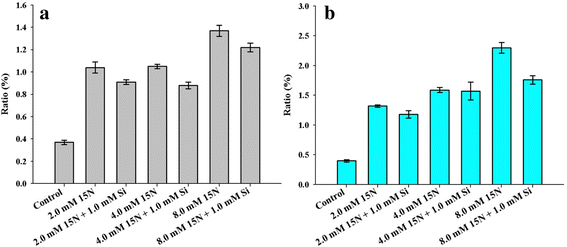Exogenous short-term silicon application regulates macro-nutrients, endogenous phytohormones, and protein expression in Oryza sativa L
- PMID: 29301510
- PMCID: PMC5755014
- DOI: 10.1186/s12870-017-1216-y
Exogenous short-term silicon application regulates macro-nutrients, endogenous phytohormones, and protein expression in Oryza sativa L
Abstract
Background: Silicon (Si) has been known to regulate plant growth; however, the underlying mechanisms of short-term exogenous Si application on the regulation of calcium (Ca) and nitrogen (N), endogenous phytohormones, and expression of essential proteins have been little understood.
Results: Exogenous Si application significantly increased Si content as compared to the control. Among Si treatments, 1.0 mM Si application showed increased phosphorus content as compared to other Si treatments (0.5, 2.0, and 4.0 mM). However, Ca accumulation was significantly reduced (1.8- to 2.0-fold) at the third-leaf stage in the control, whereas all Si treatments exhibited a dose-dependent increase in Ca as determined by radioisotope 45Ca analysis. Similarly, the radioisotope 15N for nitrogen localization and uptake showed a varying but reduced response (ranging from 1.03-10.8%) to different Si concentrations as compared to 15N application alone. Physiologically active endogenous gibberellin (GA1) was also significantly higher with exogenous Si (1.0 mM) as compared to GA20 and the control plants. A similar response was noted for endogenous jasmonic and salicylic acid synthesis in rice plants with Si application. Proteomic analysis revealed the activation of several essential proteins, such as Fe-S precursor protein, putative thioredoxin, Ser/Thr phosphatase, glucose-6-phosphate isomerase (G6P), and importin alpha-1b (Imp3), with Si application. Among the most-expressed proteins, confirmatory gene expression analysis for G6P and Imp3 showed a similar response to those of the Si treatments.
Conclusions: In conclusion, the current results suggest that short-term exogenous Si can significantly regulate rice plant physiology by influencing Ca, N, endogenous phytohormones, and proteins, and that 1.0 mM Si application is more beneficial to plants than higher concentrations.
Keywords: Gibberellins; Glucose-6-phosphate isomerase; Importin alpha 1b; Jasmonic acid; Protein expression; Radioisotope 45Ca; Silicon application.
Conflict of interest statement
Ethics approval and consent to participate
The rice seeds, Dongjin, is very a common and broadly cultivated variety in South Korea. The seeds were procured from the National Institute of Crop Science, Rural Development Administration, South Korea. Our project does not used transgenic technology therefore it does not require ethical approval.
Consent for publication
Not applicable.
Competing interests
The authors declare that they have no competing interests.
Publisher’s Note
Springer Nature remains neutral with regard to jurisdictional claims in published maps and institutional affiliations.
Figures







References
-
- Feng J, Shi Q, Wang X. Effects of exogenous silicon on photosynthetic capacity and antioxidant enzyme activities in chloroplast of cucumber seedlings under excess manganese. Agri. Sci China. 2009;8:40–50.
-
- Kim YH, Khan AL, Kim DH, Lee SY, Kim KM, Waqas M, Jung HY, Shin JH, Kim JG, Lee IJ. Silicon mitigates heavy metal stress by regulating P-type heavy metal ATPases, Oryza sativa low silicon genes, and endogenous phytohormones. BMC Plant Biol. 2014;14:13. doi: 10.1186/1471-2229-14-13. - DOI - PMC - PubMed
-
- Kim YH, Khan AL, Waqas M, Shim JK, Kim DH, Lee KY, Lee IJ. Silicon application to rice root zone influenced the phytohormonal and antioxidant responsesunder salinity stress. J Plant Growth Regul. 2014;33:137–149. doi: 10.1007/s00344-013-9356-2. - DOI
Publication types
MeSH terms
Substances
Grants and funding
LinkOut - more resources
Full Text Sources
Other Literature Sources
Miscellaneous

